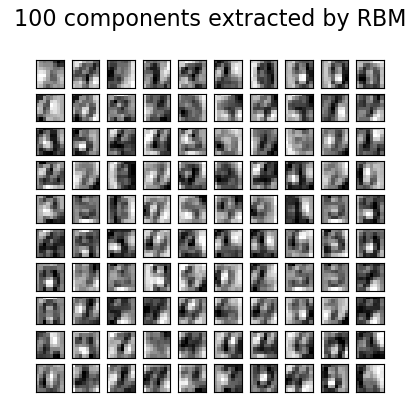sklearn.neural_network.BernoulliRB?
class sklearn.neural_network.BernoulliRBM(n_components=256, *, learning_rate=0.1, batch_size=10, n_iter=10, verbose=0, random_state=None)
[源碼]
伯努利限制玻爾茲曼機(RBM)。
具有二值化可見單位和二值化隱藏單位的限制玻爾茲曼機。參數估計使用隨機最大似然(SML),也稱為持久對比散度(PCD)[2]。
這個實現的時間復雜度為O(d ** 2)假定d?n_features?n_components。
在用戶指南中閱讀更多內容。
| 參數 | 說明 |
|---|---|
| n_components | int, default=256 二值化隱藏單位數 |
| learning_rate | float, default=0.1 用于權重更新的學習率。強烈建議調優這個超參數。合理值在10 ** [0.,-3.]范圍內。 |
| batch_size | int, default=10 每個小批量的樣本數量。 |
| n_iter | int, default=10 訓練數據集在訓練期間要執行的迭代或掃描次數。 |
| verbose | int, default=0 詳細程度。默認為零,表示靜默模式。 |
| random_state | integer or RandomState, default=None 確定以下各項的隨機數生成: - 從可見層和隱藏層進行吉布斯(Gibbs)采樣。 - 初始化組件,在擬合過程中從層中采樣。 - 在對樣本評分時破壞數據。 在多個函數調用之間傳遞一個整數以獲得可重復的結果。請參閱詞匯表。 |
| 屬性 | 說明 |
|---|---|
| intercept_hidden_ | array-like, shape (n_components,) 隱藏單位的偏差。 |
| intercept_visible_ | array-like, shape (n_features,) 可見單位的偏差。 |
| components_ | array-like, shape (n_components, n_features) 權重矩陣,可見單元數中的n_features和n_components是隱藏單元數。 |
| h_samples_ | array-like, shape (batch_size, n_components) 隱藏激活是從模型分布中采樣的,其中,每個小批量的示例數中的batch_size和n_components是隱藏單元數。 |
參考文獻
[1] Hinton, G. E., Osindero, S. and Teh, Y. A fast learning algorithm for
deep belief nets. Neural Computation 18, pp 1527-1554. https://www.cs.toronto.edu/~hinton/absps/fastnc.pdf
[2] Tieleman, T. Training Restricted Boltzmann Machines using
Approximations to the Likelihood Gradient. International Conference on Machine Learning (ICML) 2008
示例
>>> import numpy as np
>>> from sklearn.neural_network import BernoulliRBM
>>> X = np.array([[0, 0, 0], [0, 1, 1], [1, 0, 1], [1, 1, 1]])
>>> model = BernoulliRBM(n_components=2)
>>> model.fit(X)
BernoulliRBM(n_components=2)
方法
| 方法 | 說明 |
|---|---|
fit(X[, y]) |
將模型擬合到數據X。 |
fit_transform(X[, y]) |
擬合數據,然后對其進行轉換。 |
get_params([deep]) |
獲取這個估計器的參數 |
gibbs(v) |
執行一個吉布斯采樣步驟。 |
partial_fit(X[, y]) |
將模型擬合到數據X,其中應包含數據的一部分。 |
score_samples(X) |
計算X的偽似然。 |
set_params(**params) |
為這個估計器設置參數 |
transform(X) |
計算隱藏層激活概率P(h = 1/v=X) |
__init__(n_components=256, *, learning_rate=0.1, batch_size=10, n_iter=10, verbose=0, random_state=None)
[源碼]
初始化self。詳情可參閱 type(self)的幫助。
fit(X, y=None)
[源碼]
將模型擬合到數據X。
| 參數 | 說明 |
|---|---|
| X | {array-like, sparse matrix} of shape (n_samples, n_features) 用于訓練的數據。 |
| 返回值 | 說明 |
|---|---|
| self | BernoulliRBM 擬合的模型。 |
fit_transform(X, y=None, **fit_params)
[源碼]
擬合數據,然后對其進行轉換。
使用可選參數fit_params將擬合轉換到X和y,并返回X的轉換版本。
| 參數 | 說明 |
|---|---|
| X | {array-like, sparse matrix, dataframe} of shape (n_samples, n_features) |
| y | ndarray of shape (n_samples,), default=None 目標值 |
| **fit_params | dict 其他擬合參數。 |
| 返回值 | 說明 |
|---|---|
| X_new | ndarray array of shape (n_samples, n_features_new) 轉換后的數組。 |
get_params(deep=True)
[源碼]
獲取這個估計器的參數
| 參數 | 說明 |
|---|---|
| deep | bool, default=True 如果為True,則將返回這個估計器的參數和所包含的估計器子對象。 |
| 返回值 | 說明 |
|---|---|
| params | mapping of string to any 參數名映射到其值。 |
gibbs(v)
[源碼]
執行一個吉布斯采樣步驟。
| 參數 | 說明 |
|---|---|
| v | ndarray of shape (n_samples, n_features) 可見層的起始值 |
| 返回值 | 說明 |
|---|---|
| v_new | ndarray of shape (n_samples, n_features) 一個吉布斯步驟后,可見層的值。 |
partial_fit(X, y=None)
[源碼]
將模型擬合到數據X,其中應包含數據的一部分。
| 參數 | 說明 |
|---|---|
| X | ndarray of shape (n_samples, n_features) 用于訓練的數據 |
| 返回值 | 說明 |
|---|---|
| self | BernoulliRBM 擬合的模型 |
score_samples(X)
[源碼]
計算X的偽似然。
| 參數 | 說明 |
|---|---|
| X | {array-like, sparse matrix} of shape (n_samples, n_features) 可見層的值。必須為全布爾值(不檢查)。 |
| 返回值 | 說明 |
|---|---|
| pseudo_likelihood | ndarray of shape (n_samples,) 偽似然的值(似然的代理)。 |
注
這種方法是不確定的:它計算一個稱為X上的自由能的量,然后計算一個隨機損壞的X版本,并返回差的logistic函數的對數。
set_params(**params)
[源碼]
為這個估計器設置參數
| 參數 | 說明 |
|---|---|
| **params | dict 估計器參數 |
| 返回值 | 說明 |
|---|---|
| self | object 估計器實例 |
transform(X)
[源碼]
計算隱藏層激活概率P(h = 1 | v = X)。
| 參數 | 說明 |
|---|---|
| X | {array-like, sparse matrix} of shape (n_samples, n_features) 要轉換的數據。 |
| 返回值 | 說明 |
|---|---|
| h | ndarray of shape (n_samples, n_components) 數據的潛在表示。 |

